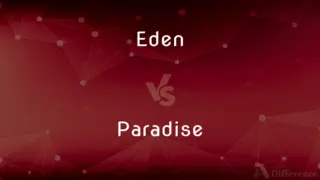Diaeresis vs. Umlaut — What's the Difference?
By Urooj Arif & Maham Liaqat — Updated on May 2, 2024
Diaeresis indicates that two adjacent vowels are pronounced separately, as in "naïve," while an umlaut signifies a sound change in the vowels, primarily in Germanic languages, as in "führer."

Difference Between Diaeresis and Umlaut
Table of Contents
ADVERTISEMENT
Key Differences
Diaeresis, often seen in English and other languages, is a diacritical mark consisting of two dots (¨) placed over a vowel to signal that the vowel should be pronounced apart from the vowel before it, ensuring that each vowel maintains its own syllable. On the other hand, the umlaut, also marked by two dots, is used primarily in German and some other languages to indicate a change in the sound of the vowels a, o, and u.
In terms of usage, a diaeresis is used in words where vowels might otherwise be mistaken for a diphthong or a silent vowel, as in "coöperate" where it prevents the blending of the two 'o's into a single sound. Whereas, an umlaut changes the pronunciation of the vowels: "a" becomes the fronted sound [æ], "o" is changed to [ø], and "u" to [y].
The diaeresis is also used in loanwords and names where pronunciation may not be intuitive for English speakers, such as in the name "Brontë." Conversely, the umlaut has grammatical implications in German, affecting word forms and pluralization, such as changing "Mutter" (mother) to "Mütter" (mothers).
While the visual representation of diaeresis and umlaut is the same, their functions are quite distinct. The diaeresis prevents the merging of vowels into a single syllable, maintaining clarity in pronunciation, whereas the umlaut fundamentally alters the vowel sound to convey different lexical or grammatical meanings.
While the diaeresis appears primarily in literary or formal contexts to aid pronunciation, the umlaut is integral to everyday language use in German, affecting the basic sounds of words and thereby their meanings and roles within sentences.
ADVERTISEMENT
Comparison Chart
Function
Indicates separate pronunciation of vowels
Indicates changed vowel pronunciation
Language Usage
English, French, and others
Primarily German and other Germanic languages
Pronunciation Effect
Keeps vowels in separate syllables
Alters vowel sounds
Grammatical Impact
Minimal
Significant in German
Common Words
Naïve, coöperate
Führer, schön
Compare with Definitions
Diaeresis
Common in personal and place names to signal pronunciation.
Chloë ensures the name is pronounced in two syllables.
Umlaut
Affects pluralization and conjugation in German.
Apfel becomes Äpfel (apples) in the plural.
Diaeresis
Ensures vowels do not blend into a single sound.
Zoë is pronounced Zo-ee instead of Zo.
Umlaut
Changes the sound of the vowels to front-rounded vowels.
Schön (beautiful) where the o becomes an ö.
Diaeresis
Often found in poetry to maintain meter or correct pronunciation.
Coöperate in older texts ensures clear pronunciation.
Umlaut
Two dots over a, o, or u to indicate a phonetic change.
Führer shows a pronunciation shift from Fuhrer.
Diaeresis
Two dots placed over a vowel to indicate separate syllable pronunciation.
In Noël, the diaeresis tells you to pronounce it as No-el.
Umlaut
The umlaut is characteristic of Germanic language aesthetics and sound.
Many bands use umlauts in their names for a Germanic feel, such as Motörhead.
Diaeresis
Helps maintain the original pronunciation of borrowed words.
The diaeresis in naïve keeps the original French pronunciation.
Umlaut
A change in a vowel sound caused by partial assimilation especially to a vowel or semivowel occurring in the following syllable.
Diaeresis
Variant of dieresis.
Umlaut
A vowel sound changed in this manner. Also called vowel mutation.
Diaeresis
(orthography) A diacritic ( ¨ ) placed over a vowel letter (especially the second of two consecutive ones) indicating that it is sounded separately, usually forming a distinct syllable, as in the English words naïve, Noël and Brontë, the French haïr and the Dutch ruïne.
Umlaut
The diacritic mark (¨) placed over a vowel to indicate an umlaut, especially in German.
Diaeresis
Distraction; the separation of a vowel, often a diphthong, into two distinct syllables.
Umlaut
To modify by umlaut.
Diaeresis
(prosody) A natural break in rhythm when a word ends at the end of a metrical foot, in a line of verse.
Umlaut
To write or print (a vowel) with an umlaut.
Diaeresis
Hiatus; the occurrence of separate vowel sounds in adjacent syllables without an intervening consonant.
Umlaut
(linguistics) An assimilatory process whereby a vowel is pronounced more like a following vocoid that is separated by one or more consonants.
Diaeresis
The separation or resolution of one syllable into two; - the opposite of synæresis.
Umlaut
(linguistics) The umlaut process (as above) that occurred historically in Germanic languages whereby back vowels became front vowels when followed by syllable containing a front vocoid (e.g. Germanic lūsiz > Old English lȳs(i) > Modern English lice).
Diaeresis
A mark consisting of two dots [
Umlaut
(linguistics) A vowel so assimilated.
Diaeresis
A diacritical mark (two dots) placed over a vowel in German to indicate a change in sound
Umlaut
(orthography) The diacritical mark ( ¨ ) placed over a vowel when it indicates a (rounded) front vowel
Umlaut
A diaeresis.
Naïve takes an umlaut as it's pronounced as two syllables.
Umlaut
(transitive) To place an umlaut over (a vowel).
Umlaut
To modify (a word) so that an umlaut is required in it.
An umlauting vowel
Umlaut
The euphonic modification of a root vowel sound by the influence of a, u, or especially i, in the syllable which formerly followed.
Umlaut
A diacritical mark (two dots) placed over a vowel in German to indicate a change in sound
Umlaut
Integral to the correct pronunciation of many German words.
Mädchen (girl) where the a becomes ä.
Common Curiosities
What is the primary purpose of a diaeresis in English?
To indicate that two adjacent vowels are pronounced in separate syllables, rather than as a diphthong.
Can diaeresis and umlaut be used interchangeably?
No, they serve different purposes; diaeresis separates vowel sounds, and umlaut changes them.
Why is the umlaut important in German grammar?
It affects verb conjugations and noun pluralizations, playing a critical role in the grammatical structure of the language.
Are there any other languages that use the diaeresis like English?
Yes, several languages including French and Spanish use diaeresis to indicate that vowels should be pronounced separately.
How does an umlaut affect the pronunciation of German words?
It changes the sound of the vowels to distinct, front-rounded vowel sounds, which are crucial for correct pronunciation and meaning.
What are some common mistakes in using diaeresis and umlaut for learners?
Confusing the purpose and effect of each, such as using an umlaut to separate vowels or misunderstanding the pronunciation changes imposed by an umlaut.
Does English have any words that originally used an umlaut?
English does not use the umlaut; however, it has borrowed words from German that retain their umlauts for proper pronunciation.
How do native speakers of German perceive the importance of the umlaut?
It is considered essential for accurate communication, affecting both the meaning of words and the nuances of pronunciation.
How do diaeresis and umlaut impact automated text processing?
They can pose challenges in encoding and font compatibility, especially in systems not designed to handle diacritical marks properly.
What should writers remember when using diaeresis and umlaut in texts?
To use diaeresis for clarity in vowel separation in English and to maintain the phonetic integrity of German words with umlauts for accurate representation and understanding.
Share Your Discovery

Previous Comparison
Eden vs. Paradise
Next Comparison
Canape vs. CanoeAuthor Spotlight
Written by
Urooj ArifUrooj is a skilled content writer at Ask Difference, known for her exceptional ability to simplify complex topics into engaging and informative content. With a passion for research and a flair for clear, concise writing, she consistently delivers articles that resonate with our diverse audience.
Co-written by
Maham Liaqat















































